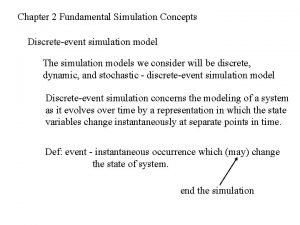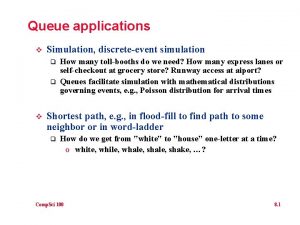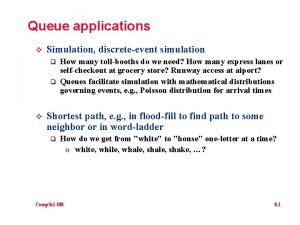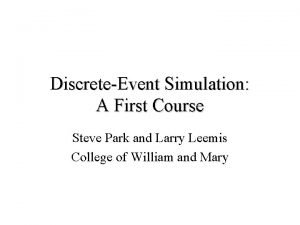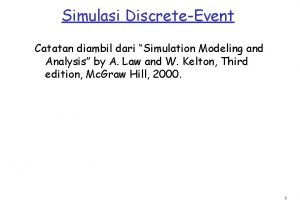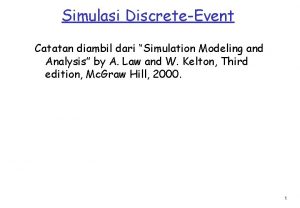DiscreteEvent Simulation and Performance Evaluation 01204525 Wireless Sensor

























- Slides: 25

Discrete-Event Simulation and Performance Evaluation 01204525 Wireless Sensor Networks and Internet of Things Chaiporn Jaikaeo (chaiporn. j@ku. ac. th) Department of Computer Engineering Kasetsart University Materials taken from lecture slides by Karl and Willig Cliparts taken from openclipart. org Last updated: 2018 -10 -27

Outline • Software installation • Discrete-event simulation concept • Introduction to Sim. Py • Introduction to Wsn. Sim. Py 2

Software Installation • Run pip install in your virtual environment to download and install necessary modules pip install simpy wsnsimpy ipython numpy scipy matplotlib jupyter pandas 3

Discrete-Event Simulation • Simulated operations are performed as a discrete sequence of events in time • "Time" stops during event processing new event(s) Initial Events Process event Fetch next event & update simulation time Event queue (sorted by event time) 4

Sim. Py Simulator • Process-based discrete-event simulator written in Python • Simulated processes are defined as Python coroutines (i. e. , generators) 5

Sim. Py Example • The following code simulates cars arriving at three toll booths at random points in time ◦ Assuming cars' inter-arrival times are exponentially distributed, with the average inter-arrival time of 30 seconds import numpy as np import simpy def booth(name, env): count = 0 while True: yield env. timeout(np. random. exponential(30)) count += 1 print(f"At {env. now: 3. 0 f} seconds, car #{count} arrives at {name}") env = simpy. Environment() env. process(booth("Booth 1", env)) env. process(booth("Booth 2", env)) env. process(booth("Booth 3", env)) env. run(until=300) 6

Introduction to Wsn. Sim. Py • WSN simulator based on Sim. Py • Implements basic Node model and simple collision-free node-to-node communication 7

Scripting Wsn. Sim. Py • Define a subclass of wsnsimpy. Node with the following methods: ◦ init() – (optional) called on each node before start of the first node's process ◦ run() – defines each node's main process ◦ on_receive() – called when a node receives a message ◦ finish() – (optional) called on each node after simulation ends 8

Case Study: Gossip Protocol • A source broadcasts a message to all nodes in the network • Similar to flooding, but each node decides to rebroadcast with some probability 9

Simulation Setup gossip. py import random import wsnsimpy as wsp def runsim(prob, source): sim = wsp. Simulator(until=50) # place nodes in 100 x 100 grids for x in range(10): for y in range(10): px = 50 + x*60 + random. uniform(-20, 20) py = 50 + y*60 + random. uniform(-20, 20) node = sim. add_node(Gossip. Node, (px, py)) # save simulation-wide variables in the 'sim' object sim. gossip_prob = prob sim. source = source # start simulation sim. run() 10

Node Model gossip. py class Gossip. Node(wsp. Node): tx_range = 100 def run(self): if self. id == self. sim. source: self. success = True yield self. timeout(2) self. broadcast() else: self. success = False def broadcast(self): if self. id == self. sim. source or random() <= self. sim. gossip_prob: self. log(f"Broadcast message") self. send(wsp. BROADCAST_ADDR) def on_receive(self, sender, **kwargs): self. log(f"Receive message from {sender}") if self. success: self. log(f"Message seen; reject") return self. log(f"New message; prepare to rebroadcast" ) self. success = True yield self. timeout(random. uniform(0. 5, 1. 0)) self. broadcast() 11

Running Simulation • Start Python console • Import the gossip module • Call the runsim() function • E. g. , the following dialog starts the simulation with gossip probability of 0. 7 and 8 as the source node >>> import gossip >>> gossip. runsim(0. 7, 8) 12

Visualizing Simulation • Wsn. Sim. Py provides wsnsimpy_tk module to take care of visualizing transmission and receptions of messages using the Tk framework gossip. py import random import wsnsimpy_tk as wsp def runsim(prob, source): sim = wsp. Simulator( until=50, timescale=1, terrain_size=(600, 600), visual=True) : : 13

Visualizing Simulation • Use Node. scene object to control animation scene • The following modification will make nodes turn bold after broadcasting and turn red after receiving gossip. py class Gossip. Node(wsp. Node): : def broadcast(self): if self. id == self. sim. source or random() <= self. sim. gossip_prob: self. log(f"Broadcast message") self. send(wsp. BROADCAST_ADDR) self. scene. nodewidth(self. id, 3) def on_receive(self, sender, **kwargs): self. scene. nodecolor(self. id, 1, 0, 0) self. log(f"Receive message from {sender}") if self. success: self. log(f"Message seen; reject") return self. log(f"New message; prepare to rebroadcast" ) self. success = True yield self. timeout(random. uniform(0. 5, 1. 0)) self. broadcast() 14

Simulation Scenarios • Number of nodes: 100 • Transmission range: 125 • Gossip probabilities: 0. 1 – 1. 0 15

Evaluation Metrics • Message delivery ratio (i. e. , #successes/#nodes) • Total number of transmissions • Total number of receptions 16

Fixing Random Seed • Each run yields different behaviors and results due to randomness • Make each run deterministic by setting the random seed gossip. py import random import wsnsimpy_tk as wsp def runsim(seed, prob, source): random. seed(seed) sim = wsp. Simulator( until=50, timescale=1, terrain_size=(600, 600), visual=True) : : 17

Disabling Logging and GUI • To speedup simulation, logging and visualization should be disabled gossip. py class Gossip. Node(wsp. Node): tx_range = 100 def run(self): self. logging = False if self. id == self. sim. source: self. success = True yield self. timeout(2) self. broadcast() else: self. success = False : gossip. py def runsim(seed, prob, source): random. seed(seed) sim = wsp. Simulator( until=50, timescale=0, terrain_size=(600, 600), visual=False) : 18

Reporting Statistics gossip. py class Gossip. Node(wsp. Node): tx_range = 100 def run(self): self. tx = 0 self. rx = 0 if self. id == self. sim. source: self. success = True yield self. timeout(2) self. broadcast() else: self. success = False Nodes must keep track of how many transmissions and receptions have occurred def broadcast(self): if self. id == self. sim. source or random() <= self. sim. gossip_prob: self. log(f"Broadcast message") self. send(wsp. BROADCAST_ADDR) self. tx += 1 def on_receive(self, sender, **kwargs): self. rx += 1 self. log(f"Receive message from {sender}") if self. success: self. log(f"Message seen; reject") return self. log(f"New message; prepare to rebroadcast") self. success = True yield self. timeout(random. uniform(0. 5, 1. 0)) self. broadcast() 19

Reporting Statistics gossip. py import random import wsnsimpy_tk as wsp def runsim(prob, source): sim = wsp. Simulator(until=50, timescale=0, visual=False) # place nodes in 100 x 100 grids for x in range(10): for y in range(10): px = 50 + x*60 + random. uniform(-20, 20) py = 50 + y*60 + random. uniform(-20, 20) node = sim. add_node(Gossip. Node, (px, py)) # save simulation-wide variables in the 'sim' object sim. gossip_prob = prob sim. source = source # start simulation sim. run() After simulation ended, report the collective statistics num_successes = sum([n. success for n in sim. nodes]) num_tx = sum([n. tx for n in sim. nodes]) num_rx = sum([n. rx for n in sim. nodes]) return num_successes, num_tx, num_rx 20

Running Simulation with Script • The following script runs simulation with different sets of parameters, then save all results in a CSV file run. py import csv import numpy as np import gossip SEED = range(5) PROB = np. arange(0. 1, 1. 1, . 2) with open("results. csv", "w") as out: writer = csv. writer(out) writerow(['seed', 'prob', 'success', 'tx', 'rx']) for seed in SEED: print(f"Running seed: {seed}") for prob in PROB: success, tx, rx = gossip. runsim(seed, prob, 50) writerow([seed, prob, success, tx, rx]) 21

Processing Raw Data • Raw results in the CSV file can be conveniently processed with pandas • Jupyter notebook provides a great environment for manipulating and visualizing data • Start Jupyter notebook with the command (after entering the virtual environment) jupyter notebook • Then click New -> Python 3 to create a new notebook 22

Loading CSV file • Enter and run the following cell to load the pandas library and read simulation results into a data frame %matplotlib notebook import pandas as pd data = pd. read_csv("results. csv") • Add reachability ratio as a new series to the data frame data["ratio"] = data. success / 100 • The data frame should now look like: data 23

Summarizing Results • Data. Frame's groupby method can be used to summarize results from the same probability but across different seeds agg = data. groupby("prob") ratio = agg. ratio. mean() ratio 24

Plotting Results • The resulting summary can be plotted using the plot() method import matplotlib. pyplot as plt ratio. plot(style="b--") ratio. plot(style="go") plt. grid(True) plt. xlabel("Gossip Probability") plt. ylabel("Reachability Ratio") 25
 Telecommunications, the internet, and wireless technology
Telecommunications, the internet, and wireless technology Wireless sensor network protocols
Wireless sensor network protocols Single node architecture in wsn
Single node architecture in wsn Habitat monitoring sensor
Habitat monitoring sensor Telosb
Telosb Geoves butterfly wireless multi sensor
Geoves butterfly wireless multi sensor Sst wireless
Sst wireless Habitat monitoring sensor
Habitat monitoring sensor Progress and performance measurement and evaluation
Progress and performance measurement and evaluation Evaluation in progress
Evaluation in progress Measurement and evaluation in human performance 5e download
Measurement and evaluation in human performance 5e download Vertical jump
Vertical jump Computer architecture performance evaluation methods
Computer architecture performance evaluation methods Portfolio performance evaluation problems
Portfolio performance evaluation problems Sales force performance management
Sales force performance management Evaluating channel member performance
Evaluating channel member performance The assessment of computer performance is called
The assessment of computer performance is called Usmc master brief sheet
Usmc master brief sheet Direct support professional performance evaluation
Direct support professional performance evaluation Performance evaluation for decentralized operations
Performance evaluation for decentralized operations Purchasing performance evaluation
Purchasing performance evaluation Citibank performance evaluation
Citibank performance evaluation Housekeeping performance improvement plan
Housekeeping performance improvement plan Principles of performance appraisal
Principles of performance appraisal Stronge leader effectiveness performance evaluation model
Stronge leader effectiveness performance evaluation model Performance evaluation using variances from standard costs
Performance evaluation using variances from standard costs


































